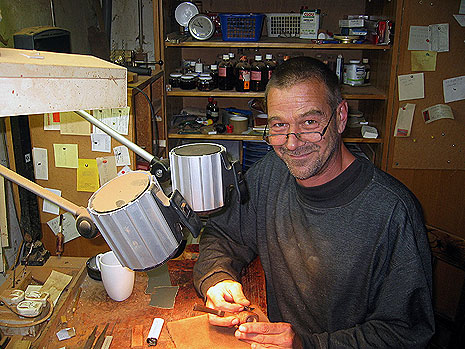
Philip
Thomson in Conversation with Peter Matzhold
Not often do I hear
one pipe maker bragging about another pipe maker’s briar. At first I did a
double take.
I had travelled to
northern Germany to meet a Danish pipe maker.
Well into the night,
after a few Pilsner and Schnaps, he began to tell me about a new selection of
briar obtained from an Austrian pipe maker named Peter Matzhold. It was
explained that this Austrian had the best briar he had ever seen and was
fortunate to purchase a number of briar block from him.
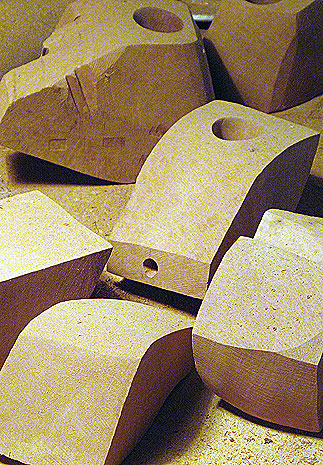
A relatively unknown
Austrian pipe maker with fantastic block was too tempting a treat to pass
up.
Eighteen month later
I had an Email address, a few month after that, I had the pleasure of meeting
the man himself. Quiet, thoughtful and passionate are the words that I find to
describe Peter Matzhold. The lines of his pipes are elegant, almost to the point
of seductive. A Matzhold pipe smokes incredibly dry and cool.
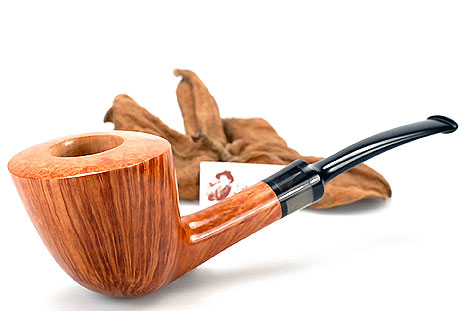
Please continue
reading below and learn more about the man with the unbelievable
briar.
“For a
person who knows nothing about you, can you please share some biographical
information about yourself? Where are you from, where and when were you born,
how did you get introduced to pipes and pipe making, and under what
circumstances did you start making pipes?”
I was born in Graz, Austria in 1952.
At the appropriate time, I began architectural studies. In school my primary
interest had been painting. I also had the urge to creative things for which I
had a daily need, using my own ideas. For example, I made my own furniture and
clothes. It only makes sense that would want to make my own pipes
too.
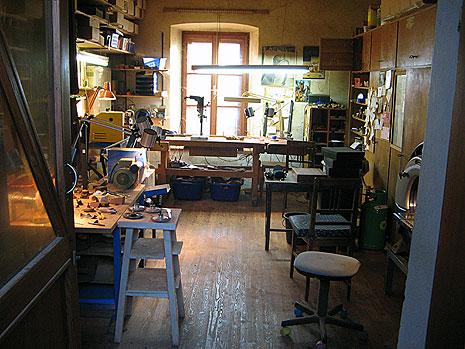
“Under what
circumstances did you decide to make pipes a occupation?”
After
five years of architectural studies, I worked on a residential building project.
During this time, I was still painting, taking pictures and making pipes for my
own use. After the project was completed, we made a presentation at an
architectural conference in Switzerland. While there, I was smoking my pipes
without really thinking about them. A businessman in Basel noticed these unique
pieces that were not for sale, and he displayed them. Following this showing, a
pipe dealer told me that I should make some pipes just like these for him to
sell. After my experiences with stress of working as an architect, making pipes
in the quiet of my own shop in order to make a living seemed very attractive,
and I began my profession as a pipe maker.
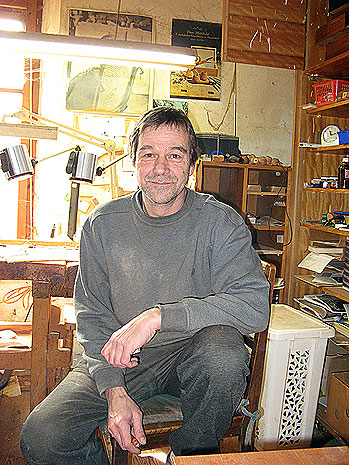
“Has any
person or persons been responsible for modelling your career or your designs?”
“If so who?”
I really wasn’t influenced by other pipe makers. I also didn’t know
anything about factory pipes. I wasn’t interested in “standard” pipes. My pipes
were sculptures and objects, which one could smoke. Sales for these “objects”
were good. But then I met the woman who was later to become my wife and we
wanted to have children. It was clear that I had to sell more pipes. So I began
to make classical pipe shapes. But I always held fast to the idea that these
pipes were not to be copies but were to be developed in their own unmistakable
style. I would describe it this way, if a smoker sees one of my pipes without
knowing who made it and thinks that this must be a Matzhold pipe, and then I
know that it as made right. “What type of briar do you use?
What type of material do you use for mouthpieces? Do you use other materials do
you use to adorn your pipes?”
I only use plateau wood that I
bought from my supplier more then ten years ago. For the stem I use only the
highest quality vulcanite. For certain applications I use other woods that I
think are attractive, like olive wood and kings wood. I also like horn with its
wonderful natural variety of colours, as opposed to the artificial colours and
forms of acrylic, which I would never use.
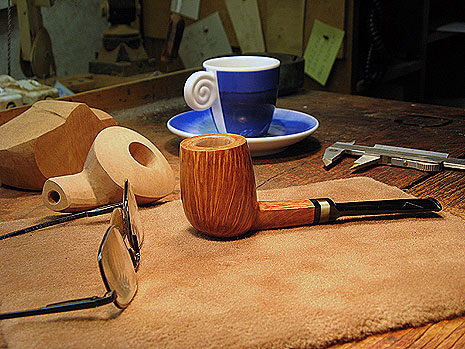
“What is the
most important aspect of a block of briar for you?”
Every
year my supplier gathers several hundred blocks from which I can make my
selection. These are, of course, more expensive. I look for the density of the
grain, as well as, the consistency of the plateau and the likelihood of finished
pieces. I don’t pay attention to how the grain runs because I have had the
experience that it is easier to make a classic shape from a consistent grain,
but a wild, irregular course of a naturally beautiful grain challenges me more,
and gives me over and over again the chance, compelled by the grain to create
new shapes and variations. An important aspect is also how I run my shop. I
started more than ten years ago to buy more wood, as was made possible by my
financial situation. I have already told my supplier last year that I wanted to
buy around eight hundred pieces. I am working with wood that has been cured a
minimum of five years in the space under my roof. When I’m not sure, at the
moment, what to make with some of the pieces of wood in my stock, I put them
aside and try later. It goes without saying, that it is very comforting to know
that I have a stock of wood that will last several years, should I not be able
to buy new wood of a quality that I would wish to have.
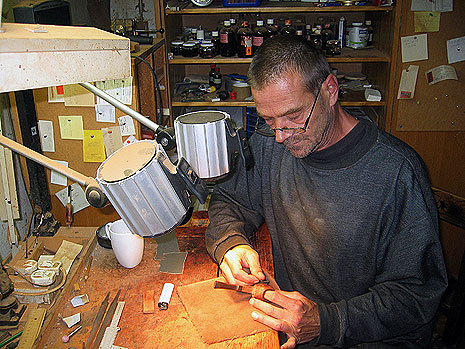
“What is the
most important aspect of the mouthpieces?”
The mouthpieces must be as
comfortable as possible when held in the mouth. The pipe cleaner must pass
easily through the stem to the bottom of the bowl, whether the pipe is straight
or bent. The mouthpiece is not simply the connection from the bowl to the mouth,
but is a component of the design. The bowl and stem mutually result in the style
and character of the pipe. Both can be seen in a continuing line of unity from
the bowl to the end of the stem or as individual components of the pipe. Each
individual bowl must have its own mouthpiece and thereby gets its
character.
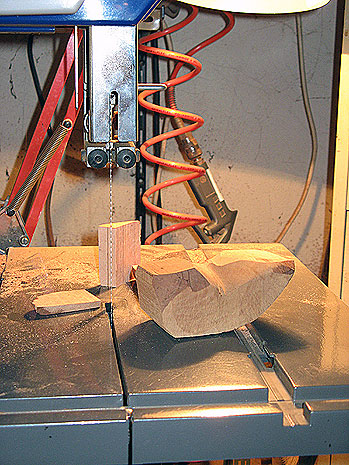
“Where do
you get your inspiration for your shapes?”
Naturally in the course of a year I
have a large variety of shapes in mind, but the block itself determines the
shape of the pipe. My procedure is not to plan to make a particular shape and
then look for a particular block to make it. I take a piece of wood and decide
what should be made from it. This not only creates much less stress for me, but
new ideas and variations always come when I deal with the uniqueness of each
block. It is essential that the bowl not be turned on the lathe and also not the
smoke hole. I do all drilling by hand after I am certain of the shape of the
pipe.
“How has
your work evolved over the years?”
“Is there one particular aspect of your
work that gives you the most satisfaction?”
Over the course of the years after
searching through the variety of shapes I have made, there is one fundamental
concern I have. That is my hope that they should be recognized by consumers. I
didn’t just dream this up, this is my personal conviction. And it seems that I
have had the good fortune that my development of shapes speaks to many pipe
smokers. If that weren’t so I couldn’t enjoy with satisfaction my profession. I
wouldn’t be me and would have to, for example, make pipes in a Danish or Italian
style. I admire these styles and have the deepest respect for those who make
them. They are one fact of an extensive supply. I am another individual in the
world of pipes, and it would be greatly satisfying for me if I were recognized
as an unmistakable individual in the pipe world.
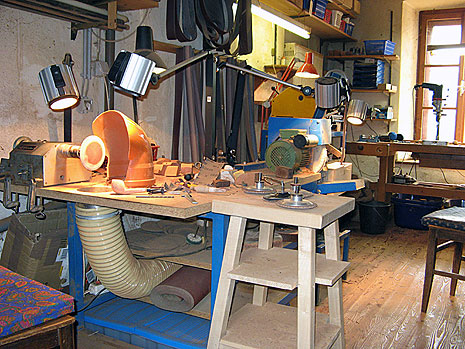
“In your
opinion, what distinguishes and identifies your work from the work of other pipe
makers?”
There are a number of pipe makers who all have the same goal – to do
their best. They are concerned with what is perfection and in exactness of
workmanship, and how their future work will reflect their understanding of shape
and style. Every pipe maker who doesn’t try to copy others but brings his own
individual uniqueness to his work enriches the pipe world.
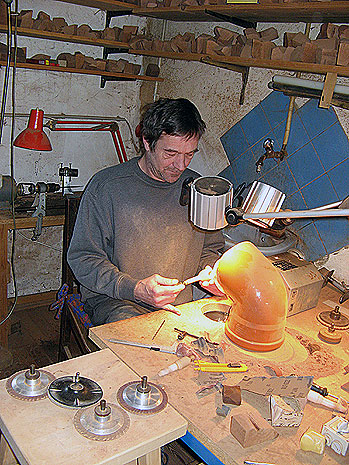
“How many
more years do you plan on making pipes?”
I will be fifty next year and know
many people who are already thinking about retirement. They must retire at some
time from their professional life. Fortunately, no one can force me to take
retirement. As I see it today, I love my work and only two things could stop it
– sickness or incapacity to work – or that pipe smokers would not want my
pipes.
After smoking a
couple of Matzhold pipes, I find it impossible to think that pipe smokers would
force Peter into retirement. Peter Matzhold, a lovely man that makes a fabulous
pipe. The simple elegance of a graining stain and carnauba wax make a Matzhold
pipe immediately recognizable.
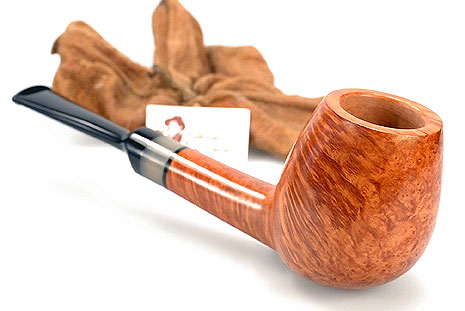
The Matzhold grading
system is easy to follow, A to G, and then his top grade CU that stands for
Casper and Una, Peter’s two
children.
Copyright © 2008 by TECON GmbH
with friendly support of Peter Matzhold & Philip Thomson |